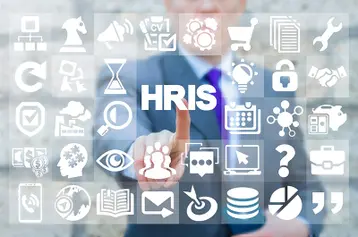
A human resources information system (HRIS) is a software system that helps to automate and streamline HR functions. It’s a centralized system that brings together a wide range of HR processes. It can make HR professionals work more efficient and productive and also help organizations that don't have the resources to staff a large human resources team.
Many people who own or manage small and medium sized businesses (SMBs) derive great benefits from HRIS software. It can enable the business to focus on other important matters while the software helps the business and its employees with HR needs. This article will present an overview of the key components of HRIS software, explain how HRIS can enhance employee experience, and discuss what factors to consider when choosing an HRIS.
Key Components of HRIS Software
HRIS software is fueled by comprehensive, detailed data on your entire workforce and your company's HR procedures, policies and goals. Using that database, an HRIS system can help with core HR processes, including hiring and onboarding, payroll management, benefits administration, compliance, and training and development. HR software should automate these functions as much as possible and execute them accurately. But a good HRIS system will offer features that enhance those basic functions and go beyond them.
Employee data management
An HRIS system should securely store worker information in an employee database. The system can also provide employees with a self-service portal so they can update their data (for example, when they move), which will save time for HR personnel.
Time tracking and attendance management
An HRIS streamlines time and attendance recordkeeping and management. The software makes it easy to track time for on-site, remote, and hybrid employees, perhaps even accommodating mobile phone access. It also simplifies the process of handling time-off requests.
Payroll management
An HRIS will integrate time tracking as it automates the processes of calculating pay and delivering it to employees. The system should handle all types of employee’s pay information, including hourly wages, overtime, salary, bonuses, and paid time off. The system can also be accessed to use for compensation benchmarking and reporting.
Employee recruitment, onboarding, and development
Recruitment involves many steps, and they must be performed consistently and quickly. Research shows that the best candidates are off the market in 10 days. For each applicant, documents may need to be sent, received, signed, and filed. Interview appointments and follow-ups may need to be scheduled. Feedback from interviewers to be gathered to use for evaluation. It’s easy for crucial pieces of information to be missed. HRIS applicant tracking systems help ensure that all the information is organized, stored, and easily accessible when you need it.
HRIS software also can provide a customized employee onboarding experience that is efficient and organized. It can help create individual development plans for current employees, makes their performance expectations clear, and helps them advance in their careers.
Benefits administration and health insurance
By using an HRIS system, employees can get information on and enroll in health insurance and other benefit plans on their own. The plans are then administered through the system.
Performance and talent management
An HRIS system can streamline performance reviews and other types of employee feedback, provide managers with data about their teams’ performance, and create learning paths for employees.
The Role of HRIS in Enhancing Employee Experience
Besides lifting the burden of time-consuming, administrative work from SMB managers or HR teams, an HRIS can help enhance employee experience.
Engaged employees are happier with their jobs, more likely to stay at the company, and more productive. An HRIS can enhance employee engagement by helping them understand their roles within the company, facilitating communication with their managers and peers, providing a transparent system for managing their performance, and helping them develop their careers with individualized learning paths.
An HRIS also can help enhance employee experience by providing employee self-service access to the system. This access provides an easy and efficient way for employees to request time off and scheduling changes, select or change benefit plans, and access HR-related information, such as employee handbooks.
Choosing an HRIS: Factors to Consider
How can you find an HRIS systems for your company? Which will suit your company’s needs? Consider these points when choosing HRIS software:
Understanding Your HR needs
Before you can choose HRIS software, you should know what you want it to do. Consider which HR tasks, in particular, take up the most time and/or would benefit the most from being automated. Look for bottlenecks in your HR workflow. See if there are any snags in the way you handle employee data during collection, storage, or retrieval. Consider if you need help with employee recruitment, onboarding, or development.
Once you have a wish list of HRIS features, set your priorities. Which of the functions are essential and which would be nice to have if you can get them within your budget?
Talk with all the people in your company who will be directly affected by the change to an HRIS system. This may include all HR personnel, management, and your technology people. Ask them what they would like to see from the system and if they have any concerns.
Evaluating HRIS features
Once you have a clear idea of what you are looking for, you can start to evaluate HRIS systems. Talk with different vendors to find out whether they provide the features on your wish list.
Considering the software's user experience
No matter what combination of features you’re looking for, you want your employees to have a positive user experience. Everyone in your company should find the software relatively easy and pleasant to use. Employee access is an important feature of an HRIS, and if the interface is complicated or confusing, employees are not going to want to use it.
The best way to get a feel for the user experience of each HRIS system you’re considering is to take it for a test drive. The vendors will offer demos, and you should participate in those.
Assessing customer support
Customer support is another important aspect of the user experience. You’ll want to know that help is readily available if you have any problems setting up or maintaining the system. There should also be a helpline for employees to use if they have questions about any aspect of the self-service employee system.
Find out if the users of the system will need to be trained or if they can pick up how to use it on their own. If training is necessary, ask if the HRIS vendor will provide it.
Free trial
Despite all your preparations, research, and vendor discussions, you won’t know for sure if an HRIS is the right fit for your company until you actually try it out. The HRIS provider may offer a free trial. A free trial goes beyond a demo and gives you a chance to use the system. This can help you assess if the HRIS meets your company’s needs.
Finding HRIS software
HRIS software can bring tremendous benefits to small and medium-sized companies. It can help save your business time and overhead, improve accuracy, helps with compliance, and streamline recruitment, onboarding, and employee development. However, all HRIS systems are not the same. To choose the best software solution for your company, you should assess your HR needs, compare different systems by talking to vendors, and evaluate each system’s features, customer service, and user experience.
Also, consider whether you need more service than an HRIS. TriNet offers a comprehensive HR solution that provides other services in addition to an HRIS. As a CPEO, TriNet provides dedicated, experienced experts to help support clients, in addition to the HRIS that helps with core HR functions, creates visual analytics reports that provide decision makers with key insights, gives employees easy access with a full-featured mobile app, and integrates with systems you’re already using. TriNet also provides access to tools for performance management, which provides you with real-time feedback, goal setting, and expectations as it relates to your employees, as well as online learning programs where your employees can access at any time. Contact TriNet for a demo to see for yourself how we can help your company.
This communication is for informational purposes only, is not legal, tax or accounting advice, and is not an offer to sell, buy or procure insurance.
This article may contain hyperlinks to websites operated by parties other than TriNet. Such hyperlinks are provided for reference only. TriNet does not control such web sites and is not responsible for their content. Inclusion of such hyperlinks on TriNet.com does not necessarily imply any endorsement of the material on such websites or association with their operators.






